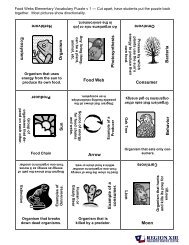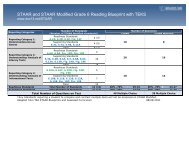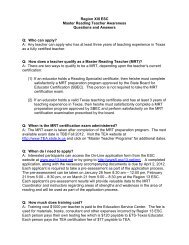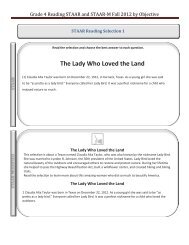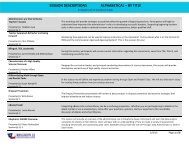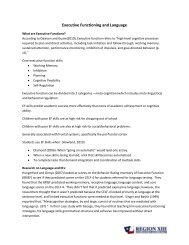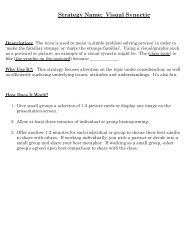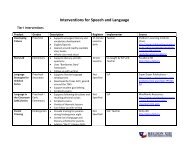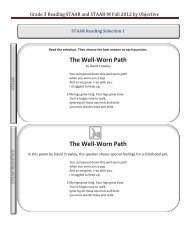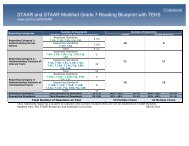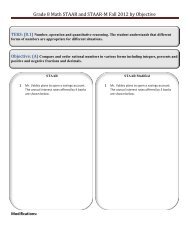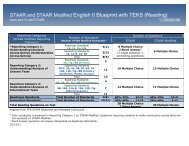2nd Six Weeks Newsletter - Region 13
2nd Six Weeks Newsletter - Region 13
2nd Six Weeks Newsletter - Region 13
Create successful ePaper yourself
Turn your PDF publications into a flip-book with our unique Google optimized e-Paper software.
2010—2011 Second <strong>Six</strong> <strong>Weeks</strong> PreviewEnglish Language ArtsKindergartenUnit 2: Authors Write for a Purpose. In Unit 1, students recognized that spoken words could be written and that sentencesare comprised of words. They began to recognize letters as upper and lower case and identified the commonsounds that each letter represents. Connections between language sounds such as rhyming and non-rhyming wordswere identified. Students listened to stories read aloud and asked and responded to questions. They communicated usingoral and written language by engaging in conversations and learned to take turns by speaking one at a time. Duringthis unit, students continue to explore phonological awareness, phonics, and print awareness for the purpose of understandingthe basic components of reading and writing. Students examine letter/sound associations, understand thatreading moves from left to right and top to bottom, and begin to decode VC and CVC words. As students explore thepurposes of text, they discuss big ideas and recurring phrases in fairy tales, lullabies, and folktales and identify topicsand details in informational text and media. Students use strategies and processes to support comprehension of textread aloud and communicate comprehension by retelling, or acting out main events. Students compose stories using thewriting process and written and oral conventions to dictate or write sentences in chronological order. They become moreproficient in writing their name and upper and lower case letters of the alphabet. In Unit 3, students use their understandingof the connections between the components to establish a continuum and fluid motion in reading and comprehensionwhile investigating literary works.1 st GradeUnit 2: Readers Read for a Purpose. In Unit 1, students utilized the fundamentals of oral and written conventions toeffectively communicate ideas, make appropriate connections, and contribute to discussions. Students read aloud usingalphabetic principle, beginning phonics skills, and sight word recognition. Students learned new academic vocabularyand interpreted text using strategies and processes. Students gained control of penmanship, spelling, and basic grammaras they generated ideas and developed drafts. During this unit, students examine literary works, informational textand media to establish purposes for reading and writing. They will identify topics in text and will determine if stories aretrue or fantasy. Strategies and processes are used to increase vocabulary and comprehension. Students continue togenerate ideas and publish stories. They establish more control of penmanship, spelling, capitalization, punctuation, andgrammar. In Unit 3, students will use their understanding of the connections between the components, processes, andstrategies to establish a continuum and fluid motion in reading and writing while investigating literary works.2 nd GradeUnit 2: Readers Respond to the Author's Purpose. Prior to this unit, students explored oral and written communicationin order to support literacy development in print awareness, phonological awareness, phonics, fluency, vocabulary,and comprehension. During this unit, students explore a variety of literary works, informational text, and media to establishpurposes for reading and writing. Students identify topics and respond to text through writing by explaining the authors’purposes. They continue to process sound/symbol relationships to encode and decode words as they becomefluent readers and writers. Strategies and processes, such as making and confirming predictions, and connections arepracticed and reinforced in order to monitor and adjust comprehension. Students continue to generate ideas in order tocreate and publish stories with a clear beginning, middle, and end. They establish more control of penmanship, spelling,capitalization, punctuation, and grammar. In Unit 3, students use their understanding of the connections between thecomponents, processes, and strategies to establish a continuum and fluid motion in reading and writing, while investigatingliterary works.3 rd GradeUnit 2: Discovering Literary Nonfiction. During this unit, students continue their exploration of literacy through thegenre of literary nonfiction using the literary forms of autobiographies and biographies. They identify and explain the differencesin points of view and connect with the experience, wisdom, and knowledge that authors portray in these literaryforms. Students investigate the use of emotional language and dialogue to analyze and connect with an author’s experienceand purpose for writing. They use structural patterns and literary features to make inferences, draw conclusions,summarize, and create new perspectives. These new perspectives expand their understanding about themselves asthey reflect upon and appreciate an author’s work. Sensory language is identified in text and explored in writing to createan experience that appeals to the senses. Vocabulary development increases with the exploration of prefixes, suffixes,homographs, homophones, and playful language, such as tongue twisters and riddles. Word study is inclusive of genrespecificvocabulary, literary terms, and appropriate vocabulary from the literature. In Grade 4, students continue to examineautobiographies and biographies by comparing and contrasting them with a fictional adaptation.7



